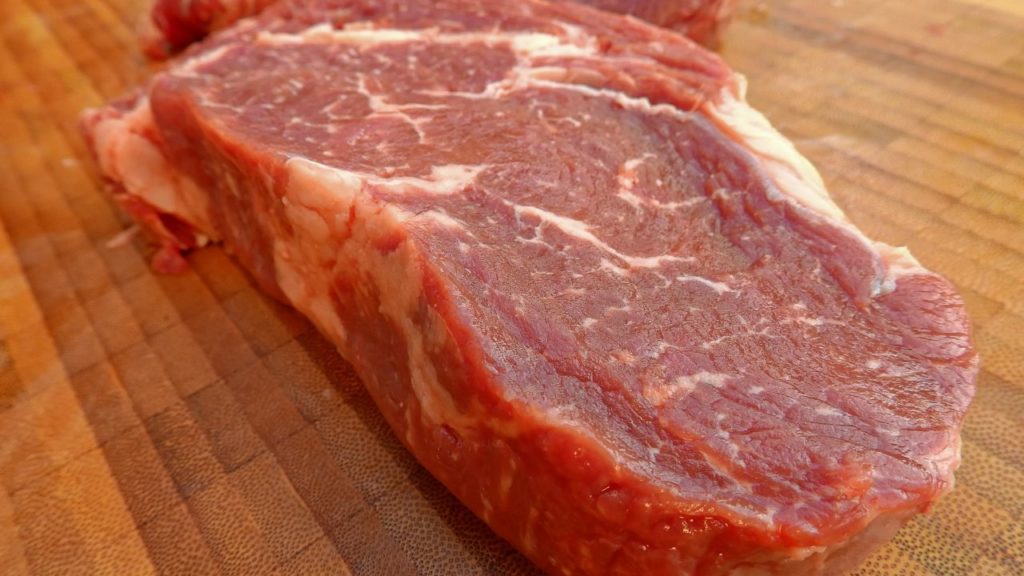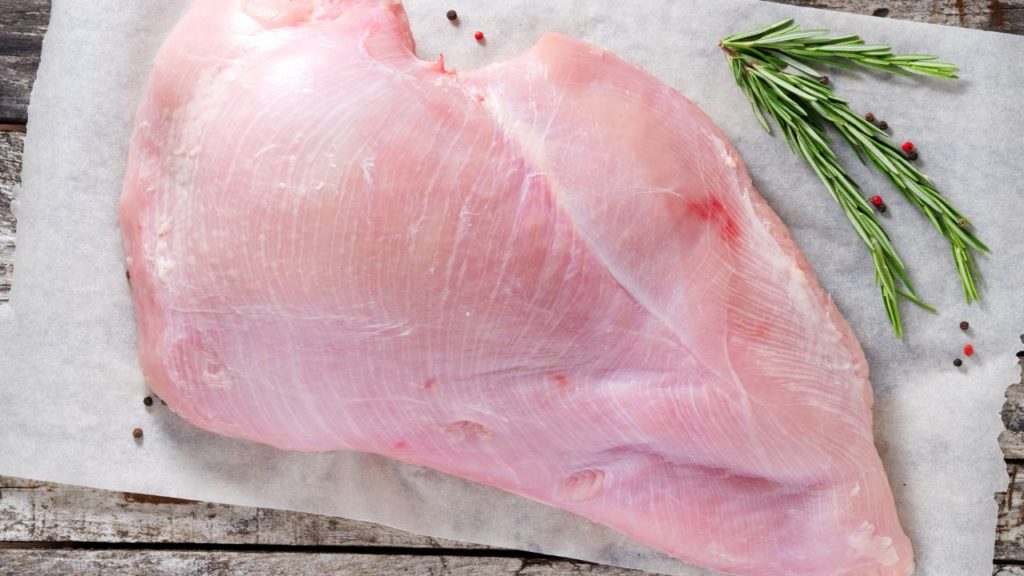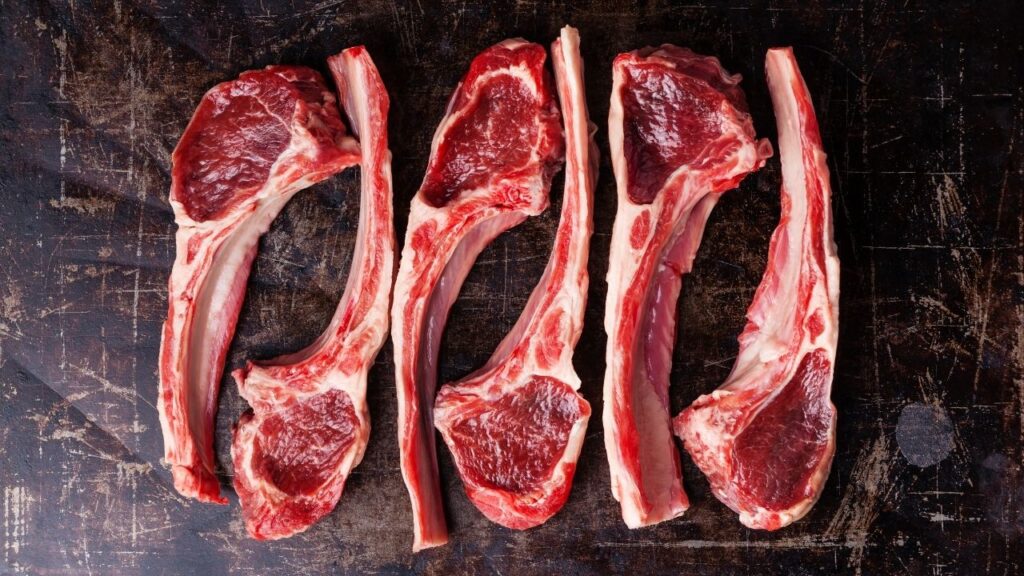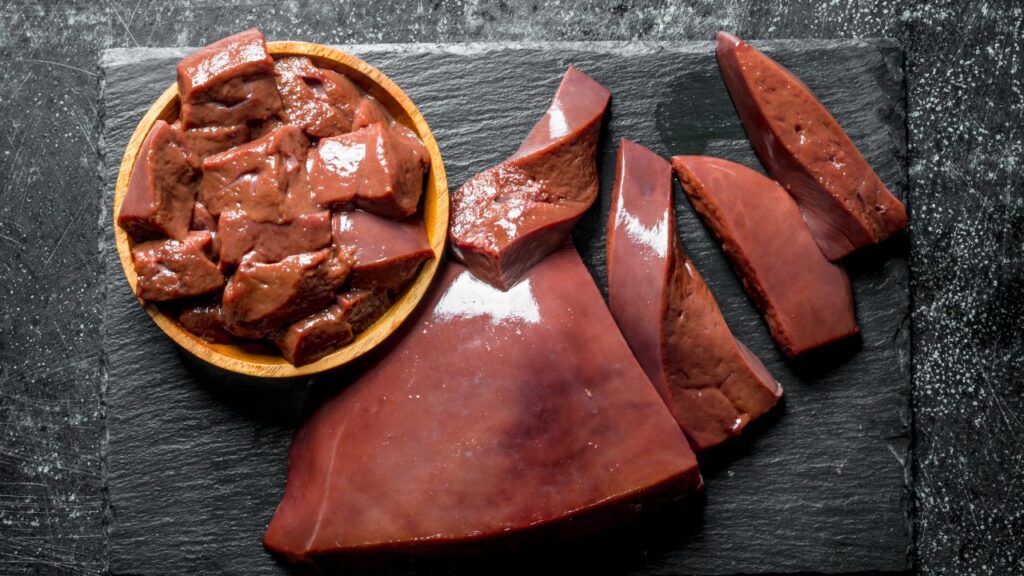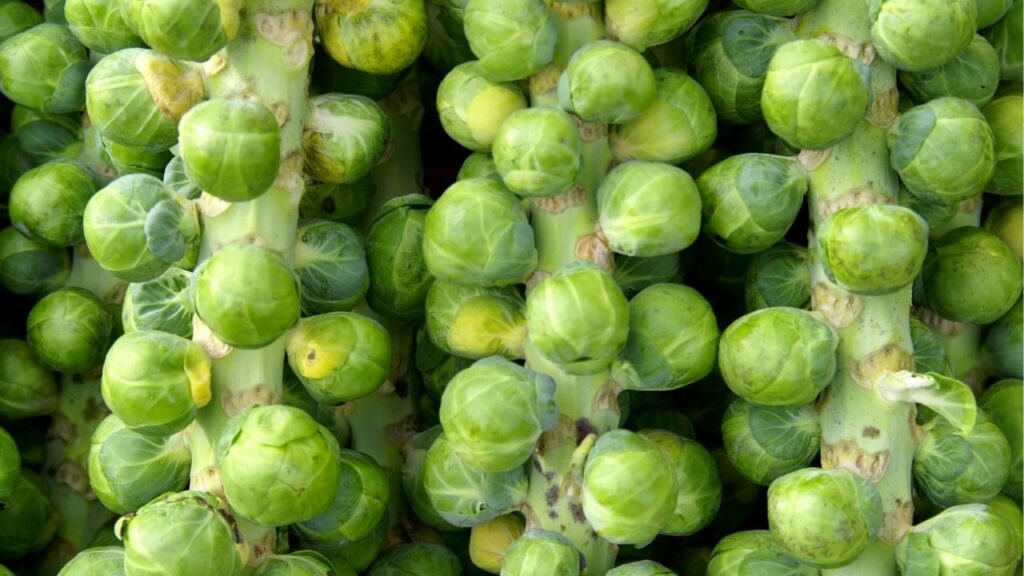Pork is a readily available protein source that can provide nutritional benefits to your dog when prepared and fed safely. Pork is available in many commercial diets as a source of amino acids and important vitamins and minerals and can provide your dog with a tasty treat at home when lean cuts are cooked without any seasonings. Ask your vet today if your pet could benefit from adding pork to their diet!
Key Takeaways
- Dogs can eat pork, as long as it is cooked, because cooking kills parasites and bacteria.
- Pork is OK in dog food. It is a good source of protein and other nutrients.
- Dogs should not eat raw pork, especially from a wild pig.
Can Dogs Eat Pork? Yes!
Pork is a red meat derived from the domestic pig. It is the number one meat consumed in the world, although consumption has declined in the United States due to the concern about its fat content. Dog lovers sometimes ask if dogs can eat pork, and the answer is yes – but some cuts and preparations are not good for dogs. We’ll cover more on this below.
It’s Not the Fat, It’s the Product
One of the main concerns about pork is its fat content. But these days, the fat in pork has declined significantly, largely due to improved genetics and the breeding and feeding of U.S. pig stock.1
Pork is available at nearly all grocery stores and butcher shops. Different cuts are available based on the area of the body it came from such as the shoulder, loin, side, and leg.
Aside from cuts of fresh pork, popular products derived from pork include sausage, ribs, bacon, pork chops, and cured or smoked ham.
Pork is an acceptable source of protein for dogs and is often present in commercial dog food as a primary meat source or included as a by-product to improve palatability (tastiness) and provide additional nutrients to the diet.2,3
Is Pork Good for Dogs?
There are many nutritional benefits to having pork included in your dog’s diet.
As with other meat sources, pork is an excellent source of protein which provides your dog with important amino acids. Lean, cooked pork has a protein content of 26%.4
Pork also provides important vitamins and minerals such as:4
- Niacin
- Vitamin B6
- Vitamin B12
- Iron
- Zinc
- Phosphorus
- Selenium
- Thiamine
All of these help to keep your dog healthy.
Even when pork is present in your dog’s food as a by-product, it still provides an important source of essential amino acids, fatty acids, vitamins, and minerals.5,6
Additionally, pork fat contains high amounts of an omega-6 fatty acid, linoleic acid, which is essential for all animals and helps your dog maintain healthy skin, haircoat, and immune system.5,6
When to Not Give Pork to Dogs
While pork can provide your dog with numerous health benefits through its protein and vitamin and mineral makeup, not all cuts of pork will be as nutritious.
If you are feeding your dog pork you are preparing at home, it is important to only feed lean pork as some cuts can contain a large amount of fat. The leanest cuts of pork include the pork loin and the tenderloin.7
Ham can also be a lean cut of meat, but many ham cuts are heavily salted and may not be appropriate for your dog.
Avoid giving your dog bones to chew on. While dogs LOVE to sit and chew on animal bones, they can provide a number of health risks including the fracturing of teeth and injury to the gastrointestinal tract through obstruction or perforation from bone splinters.
Some believe that raw bones pose less of a risk than cooked bones, but there have not been any substantial studies confirming that belief.10
Don’t Feed Raw Pork to Dogs
Raw meat diets have become increasingly popular due to perceived benefits such as increased digestibility and improvements in haircoat, skin, and energy level. While it is true that raw diets are generally more digestible than typical commercial dog foods, feeding raw pork for dogs is discouraged due to the risk of bacterial contamination.
Bacterial contamination of raw pork can result in illness not only for your dog but you as well.
Trichinellosis, infection with the parasitic trichinella worm, is one of the best-known risks from eating raw pork. Trichinellosis can result in intestinal symptoms and encysting of the parasite in the muscle. Thankfully this is now relatively rare and most often contracted from undercooked game meats.8
However, there is still an active risk of contamination from bacterial species, including antibiotic-resistant bacteria. One study that looked at commercially available freeze-dried and frozen raw dog food with a variety of protein sources found that among the diets, having a pork protein source was the only variable that was significantly associated with having antibiotic-resistant bacterial contamination. All contamination was found in the frozen diets.9
Antibiotic resistance has become increasingly dangerous as we have a limited number of antibiotics we can use to fight resistant bacteria, so it is important to reduce the risk of exposure to these germs as much as possible.9
How to Cook Pork for Dogs
If you are preparing pork to give to your dog at home, there are some guidelines that you can follow to be sure you are providing your pet with the most nutritious meat possible.
First, before you give your dog fresh cooked pork at home, you should make sure it does not cause any adverse health effects such as stomach upset or symptoms like itchiness, especially if your dog has a history of food allergies. Dogs can become allergic to different components of their diets, most often protein sources.
If you have a food allergic dog, they may react negatively to pork because it is often included in commercial diets as a by-product even if it does not explicitly appear on the label. Therefore, it is a good idea to feed a small amount of pork at a time to make sure they can tolerate it well.6 Stop feeding the pork if any allergy symptoms develop.
Cook pork without any seasonings, spices, or sauces to avoid stomach upset. Lean pork is likely to be well tolerated, but if you are feeding a fatty cut of meat, then you should only give a small amount as a treat rather than as a large portion of their meal.
When storing at home, raw pork can be kept in the freezer for 4-6 months at 0°F, and in the refrigerator for 3-5 days at 40°F.
When you are ready to start cooking, you should bake, poach, or slow cook the pork. These methods preserve nutrients. Don’t grill or otherwise sear pork. These methods could add unnecessary fat to your dog’s diet1 and the “grill marks” are carcinogenic.
After cooking pork, it should reach an internal temperature of at least 145°F to make sure any bacterial contaminants have been killed.1
Dietary Protein Recommendations
AAFCO (Association of American Feed Control Officials) sets nutritional guidelines for dog food for different life stages and helps pet parents and pet food companies make sure that they are feeding dogs a diet with all necessary dietary components.12
AAFCO recommends that an adult dog’s diet should be at least 18% protein on a dry matter basis.13 Growing dogs should be getting at least 22% protein.13 Commercial foods should list the protein content on the label: as a percentage of dry matter in dry foods, and a calorie count in wet foods.
Since each dog is an individual and has their own nutritional needs, it is important to consult your veterinarian before moving your dog to a homemade diet. Nutrient deficiencies and excesses can easily develop if you are making up your dog’s diet as you go.11
When preparing a meal for your dog at home without a set recipe, it can be very difficult to know how much of each component to feed. Much depends upon the foods you choose to use, each of which will have different nutritional profiles. You will find various ratios of protein to fat to carbs recommended in online sources, but these are usually not going to help you truly formulate a balanced diet.14 You can use resources like Balance It15 and Animal Diet Formulator to make sure you are providing your dog with a complete and balanced meal.
Where to Get Pork for Dogs
Multiple factors can influence the nutritional quality of pork. Pork in your dog’s diet might come from organically raised pigs, as part of a commercial diet, in whole meat cuts, or from by-products.
Pork can provide important nutritional benefits to your dog’s diet, but the source of the pork should be considered to determine the best way to provide it to your dog.
Organic or Not?
Pigs destined to enter the food supply can do so through traditional pork operations or through a USDA-certified organic process. Organically raised pork may only be fed organic feed and are required to have access to sunlight, the outdoors, and the opportunity to exercise. Additionally, organic pork may not be given antibiotics or growth hormone stimulants to enhance body size.19
As a result of these requirements, organic pork is generally more expensive than conventionally raised pork.
While pork from standard commercial production is nutritionally adequate, there may be some benefits to eating organic pork such as significantly higher unsaturated fatty acids and increased poly-unsaturated fatty acids.20
While meat grown in an organic process does generally have a lower amount of saturated fatty acids than conventionally raised meat, it is important to remember that there are multiple factors that contribute to the nutritional content of the product such as animal age, breed, season, and individual farm practices.20
Once slaughtered, pork enters processing and distribution facilities that package the meat for grocery stores for home consumption (typically fresh or frozen), restaurant purchase, or other food suppliers and may be available in meat, organ, or byproduct form.21
Whole Cuts or Byproducts
When pet parents pick what kind of meat to feed their dog, they may assume that meat intended for human consumption is preferable to meat in byproduct form.
Animal byproducts can provide sources of high-quality protein with a good amino acid profile while also contributing to environmental sustainability since these “scraps” do not need to be disposed of another way such as incineration or in landfills.
The primary animal byproducts for pork include meat and bone meal, meat meal, and blood meal. In fact, the natural calcium and phosphorus content of meat and bone meal are superior to meat by itself and its addition to pet foods can reduce the need for additional supplementation of those important minerals to provide a nutritionally balanced diet.3
Additionally, rendered fats can be used as another source of energy and can add flavor, texture, and additional nutrients to dog and cat food.3
Pork Chews and Rawhides
Pork can also appear in the commercial market as expanded pork or rawhide chews for dogs.
While these are incredibly appealing to dogs, they may provide an excessive amount of calories to your pet’s diet. The typical rawhide can be over 100 kcal and chew bones may have a caloric content of 1000 kcal.
This calorie content may exceed your pet’s daily energy requirement. Obesity is a common finding with companion animals, so the caloric contents of treats should be closely monitored.22
Additionally, products like pig ear rawhides have been associated with Salmonella infection and shedding in dogs, resulting in some of the same bacterial concerns as with raw diets.23
Commercial Diet or Home Cooked
Pork products appear in the pet food industry in all diet forms such as frozen food, commercial fresh food, canned wet food, and kibble. As mentioned earlier, feeding your dog a cooked diet is recommended over a raw one to reduce the risk of exposure to you and your pet with potentially harmful bacteria.
Commercial fresh cooked foods have become increasingly popular and may provide some nutritional advantages over traditional canned and kibble diets. While definitive evidence is lacking, there appears to be an improvement in digestibility for fresh cooked diets compared to dry kibble.24 These differences between the kibble and fresh cooked diets may be due to the difference in processing. Kibble is made through an extrusion process at high temperatures which may be responsible for a reduced bioavailability of the nutrients.26
- Fresh Pork from Farm to Table | Food Safety and Inspection Service. Accessed January 28, 2023. http://www.fsis.usda.gov/food-safety/safe-food-handling-and-preparation/meat/fresh-pork-farm-table
- Meeker DL, ed. Essential Rendering: All about the Animal by-Products Industry. National Renderers Association : Fats and Proteins Research Foundation : Animal Protein Producers Industry; 2006.
- Meeker DL, Meisinger JL. COMPANION ANIMALS SYMPOSIUM: Rendered ingredients significantly influence sustainability, quality, and safety of pet food. J Anim Sci. 2015;93(3):835. doi:10.2527/jas.2014-8524
- Contributors WE. Pork: Is It Good for You? WebMD. Accessed January 29, 2023. https://www.webmd.com/diet/pork-good-for-you
- Toldrá F, Mora L, Reig M. New insights into meat by-product utilization. Meat Sci. 2016;120:54-59. doi:10.1016/j.meatsci.2016.04.021
- Case LP, ed. Canine and Feline Nutrition: A Resource for Companion Animal Professionals. 3rd ed. Mosby; 2011.
- How do I choose lean meat and poultry? Accessed January 29, 2023. https://ask.usda.gov/s/article/How-do-I-choose-lean-meat-and-poultry
- CDC – Trichinellosis – General Information. Published September 18, 2020. Accessed January 30, 2023. https://www.cdc.gov/parasites/trichinellosis/gen_info/faqs.html
- Cole SD, Healy I, Dietrich JM, Redding LE. Evaluation of canine raw food products for the presence of extended-spectrum beta-lactamase- and carbapenemase-producing bacteria of the order Enterobacterales. Am J Vet Res. 2022;83(9):ajvr.21.12.0205. doi:10.2460/ajvr.21.12.0205
- Freeman LM, Chandler ML, Hamper BA, Weeth LP. Current knowledge about the risks and benefits of raw meat–based diets for dogs and cats. J Am Vet Med Assoc. 2013;243(11):1549-1558. doi:10.2460/javma.243.11.1549
- Hawn R. Homemade Pet Food Guidance: Teaching clients to avoid common pitfalls and maintain quality control. American Animal Hospital Association. https://www.aaha.org/publications/newstat/articles/2021-03/homemade-pet-food-guidance-teaching-clients-to-avoid-common-pitfalls-and-maintain-quality-control/. Published March 4, 2021. Accessed April 16, 2023.
- What is AAFCO? Association of American Feed Control Officials. https://www.aafco.org/about/. Published April 11, 2023. Accessed April 16, 2023.
- Dog Nutrition: Guide to Dog Food Nutrients. Accessed March 2, 2023. https://www.petmd.com/dog/nutrition/evr_dg_whats_in_a_balanced_dog_food
- Hospital ULV. A Beginner’s Guide to Home Cooking for Dogs. Union Lake Veterinary Hospital. Published November 20, 2018. Accessed March 5, 2023. https://unionlakeveterinaryhospital.com/blog/a-beginners-guide-to-home-cooking-for-dogs
- BalanceIT.com. Accessed January 31, 2023. https://secure.balanceit.com/ez/?rotator=NewEz
- Johnson A. Fear Free for all. dvm360. Published online February 13, 2023:10-10.
- Anthea Schick DVM DACVD. Pork, Oatmeal and Green Bean Home-cooked Diet Trial Recipe. Accessed March 2, 2023. https://cdn.sanity.io/files/0vv8moc6/dvm360/86b266237e473bf2d9c68d44d06fc7deb93b66c2.pdf
- Anthea Schick DVM DACVD. Pork, Black Bean and Quinoa Home-cooked Diet Trial Recipe. Accessed March 2, 2023. https://cdn.sanity.io/files/0vv8moc6/dvm360/e623a018e59f2aeabfc1b4ad3846580d6e7c4c89.pdf
- Organic Pig Production. Accessed January 30, 2023. https://www.ams.usda.gov/sites/default/files/media/Organic%20Pig%20Production_FINAL.pdf
- Galgano F, Tolve R, Colangelo MA, Scarpa T, Caruso MC, Yildiz F. Conventional and organic foods: A comparison focused on animal products. Cogent Food Agric. Published online January 19, 2016:1142818. doi:10.1080/23311932.2016.1142818
- Lowe M, Gereffi G. A Value Chain Analysis of the U.S. Pork Industry. Published online 2008. doi:10.13140/RG.2.1.3075.8167
- Nelson J, Burns KM. Treat Nutrition: The Why, How, and What of Proper Treating.
- Lefebvre SL, Reid-Smith R, Boerlin P, Weese JS. Evaluation of the Risks of Shedding Salmonellae and Other Potential Pathogens by Therapy Dogs Fed Raw Diets in Ontario and Alberta: The Risks of Shedding Salmonellae by Therapy Dogs Fed Raw Diets. Zoonoses Public Health. 2008;55(8-10):470-480. doi:10.1111/j.1863-2378.2008.01145.x
- Samantha_ashenhurst. How do fresh food diets compare to their commercial cousins? Veterinary Practice News. Published November 4, 2021. Accessed January 31, 2023. https://www.veterinarypracticenews.com/fresh-food-october-2021/
- Tanprasertsuk J, Perry LM, Tate DE, Honaker RW, Shmalberg J. Apparent total tract nutrient digestibility and metabolizable energy estimation in commercial fresh and extruded dry kibble dog foods. Transl Anim Sci. 2021;5(3):txab071. doi:10.1093/tas/txab071
- Algya KM, Cross TWL, Leuck KN, et al. Apparent total-tract macronutrient digestibility, serum chemistry, urinalysis, and fecal characteristics, metabolites and microbiota of adult dogs fed extruded, mildly cooked, and raw diets1. J Anim Sci. 2018;96(9):3670-3683. doi:10.1093/jas/sky235
- PNA: Nutritional Calculators. Accessed January 31, 2023. https://petnutritionalliance.org/
Topics
Did You Find This Helpful? Share It with Your Pack!
Use the buttons to share what you learned on social media, download a PDF, print this out, or email it to your veterinarian.
